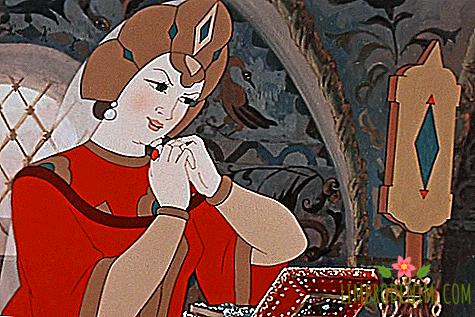Kokoshnik: The Story of "Forbidden Femininity"
World Cup 2018. Summer passes under the banner of multiculturalism and return to the roots at the same time. In Moscow, a performance by designer Maria Kazakova, working on the Jahnkoy brand, which appeals to traditional Russian craft practices, and the kokoshnik returns to the streets.
It seems that this traditional headdress had this summer to go everywhere: from the heads of Russian fans to Argentinean tourists. The general impression was also confirmed by statistics: according to RBC, sales of kokoshnik increased by 16 times, and inspired manufacturers are already going to make them for export. We recall when the first kokoshniks appeared in Russia, and we tried to figure out what they meant.

Where did the kokoshnik come from
We should start with the fact that women's hair in Slavic mythology is a rather awesome image. It was believed, for example, that the loose hair of a married woman can bring unhappiness to both her family and the whole village. The belief prohibiting walking with “fair-haired” laid the foundation for all sorts of headgear, which succeeded each other depending on the dynamics of the trade and cultural exchange of Russia. Over time, from simple bedspreads and all kinds of "horned" headdresses (crowns from unmarried, cybals and forty from married) into the ritual everyday life of rich Russian women enters a kokoshnik.
The origin of the well-known ethnic headgear is unclear. For the first time its name (derived from the word "kokosh" - "rooster", in honor of the shape of kokoshnik), is mentioned only in the 17th century. Nevertheless, historians have found descriptions of a headdress in the form of a crest and a plate as far back as Novgorod chronicles of the 10th century. There are at least three versions of the appearance of kokoshnik in Russia. The first and most popular is the "Byzantine". With the development of trade between countries, along with the cross and Orthodoxy, the daughters of Russian princes adopted high headgear from the Byzantines, which they began to wear during the Hellenistic period. However, in two other versions, Kokoshnik has Mongolian or Mordovian origin.


Wherever the kokoshnik came from, he quickly assimilated in Russia, changed and became a widespread phenomenon.
Wherever the kokoshnik came from, in Russia he quickly assimilated, changed and became a widespread phenomenon. So, originally kokoshnik was considered a festive women's headdress of the nobility, they wore it to the wedding, and in everyday life they wore its simplified likeness. Peasant women wore magpies and debris for a long time; they could not afford a kokoshnik. But over time, kokoshniki or their similarity (headdress with high ocheliem) mastered in the villages. Types of kokoshniks, their decorations and embroidery differed from the locality: in the central regions of Russia there were kokoshniks resembling a crescent moon (which we all used to see), in the north there is a one-horned cone, in the south - two-horned.
Kokoshnik was universally popular right up to Peter I's European reforms. The emperor abolished it among noblewomen and hawthorn, and since then only purely ceremonial and symbolic purpose has been attached to the kokoshnik, and the habit of wearing it has been preserved only in the villages. However, the headdress had several fashionable adventures: Catherine II, demonstrating closeness to the people, posed for parade portraits in it, and in the time of Nicholas I, who introduced the court uniform for women imitating the Russian folk costume, the kokoshnik became its obligatory part. The last state phenomenon of the kokoshnik can be dated 1903: he appeared on the ladies during a costume ball, timed to coincide with the 290th anniversary of the Romanov dynasty, to which the Russian high society dressed up in costumes of pre-Peter Russia. Needless to say, after the revolution, the "imperial spirit" was over, and the tradition of wearing national costumes, even on holidays, went along with the royal family.

Mystical and social significance
With kokoshnik associated with many rituals and, as usual in the Russian tradition, mystical superstitions. Maiden and female kokoshniks differed in their design: an unmarried girl could only wear a comb, not covering her head and braid (of course, to attract men), while a married woman was obliged to wear a kokoshnik with a veil - all traces of the same pre-Christian demonization.
The “farewell to the girl's beauty” ritual was connected with the kokoshnik after the wedding: the girl tangled the braid into two braids and covered her head with a mustache, falling to the shoulders, or a scarf, which was tied under the chin. Thus, kokoshnik became a kind of marker of the social status of women.

Femininity in Russia, on the one hand, caused fear, and on the other, it was sacralized

Kokoshnik was worn on holidays, while at the usual time they wore warriors or crowns that reminded him. For the wedding, including the peasant one, the bride’s family tried to purchase a pearl kokoshnik for it, cheaper versions were considered a disgrace and a bad omen. If there was no money, they occupied the pearly kokoshnik from the rich neighbors, and the woman wore it until the birth of the first child, and in the leading provinces - three days after the wedding. Kokoshnik was kept in the family for more than one generation: transferred from the mother to the wife of the son or the eldest daughter and was a significant part of the dowry. After the revolution, immigrants, many of whom founded their fashion houses in Paris, introduced elements of Slavic fashion into European life. Thus, the wedding crown, which remotely resembles the traditional Russian half-moon kokoshnik, became popular in the 1920s.

Embroidery value
Usually the headdress was made by kokoshnitsy masters in cities or in large villages. Kokoshniki sold at fairs, and sometimes made to order. In the course was an expensive fabric, which was embroidered with gold and silver threads, beads, colored stones in a metal frame, and then pulled it over the bark. Kokoshniki were decorated with pearl pendants, which descended on the forehead, - they were called the little girl; in the 18th century, only very rich families could afford such headwear. Each thread and the pattern were there for a reason: traditionally the center was a symbol of fertility, and on the sides were swan figures as a symbol of loyalty to the spouse and family.
The back part was decorated with a tree ("tree of life"), each branch of which imitated a new generation, and on the branches all sorts of flora and fauna were located. Golden stars were embroidered on the Kargopol kokoshniks (Arkhangelsk region), the sun was usually located on the "forehead", and the heavenly signs were on the sides. A set of secret signs also served as a talisman, femininity in Russia, on the one hand, caused fear, and on the other, it was sacralized.
National symbol
At the current football festival, kokoshnik was destined to become the symbol of everything “Russian”. Firstly, the kokoshnik is beautiful, and secondly, in the mass unconscious it is an attribute of everything fabulous, from the Swan Princess to the Snow Maiden. Kokoshnik, as part of the national costume, keeps the traditions of embroidery and handicrafts that are undeservedly forgotten. Already, the similarity of kokoshnikov can be found in European instagram brands - for example, in Eliurpi. So after the embroidery, he may well become a new fashion trend.
At the same time, few people are aware of the fact that the original kokoshnik was a symbol of the stigmatization of the most feminine image. So the current departure in the direction of masquerade (at the World Championships, men also wore en masse) was a reasonable indication that women’s hair, like women in general, should not be afraid, and married women (and unmarried) women’s hair can do not hide.
Photo: Eliurpi, Library of Congress / Prokudin-Gorskii Collection, Wikimedia Commons (1, 2, 3, 4), Mosfilm





